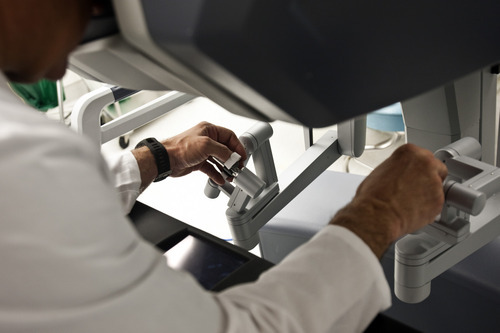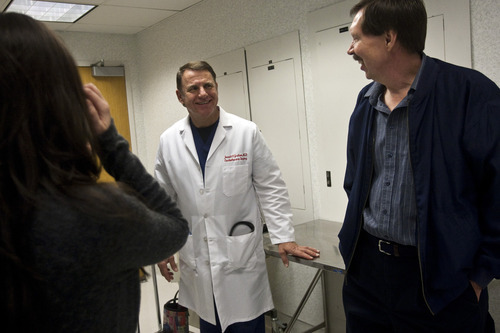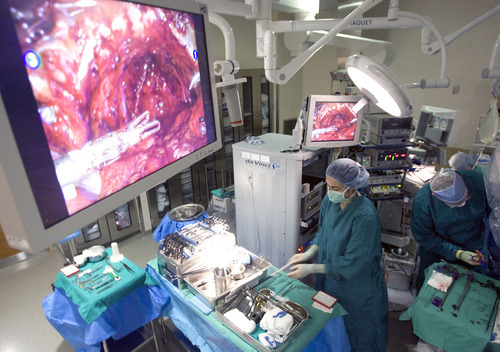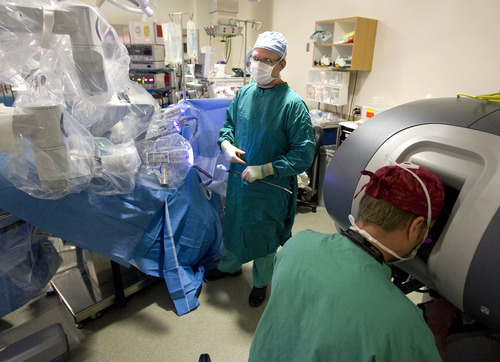This is an archived article that was published on sltrib.com in 2011, and information in the article may be outdated. It is provided only for personal research purposes and may not be reprinted.
Early in 2010, Mountain Green resident Melissa Papaj was suffering frequent migraines, numbness in her legs and overwhelming fatigue.
"I'm 30," Papaj said. "I figured I shouldn't be feeling like this."
The wedding photographer and mother of two was eventually diagnosed with a dime-sized hole in the wall of her heart, known as an atrial septic defect. In November, physician Joseph Graham used a robotic assistant to close the hole at Ogden Regional Medical Center — the first Utah hospital to use a da Vinci Surgical Systems robot for cardiothoracic surgeries.
"My recovery was amazing," Papaj said last week. "I ran 3 ½ miles yesterday. I haven't had a headache in 10 weeks."
Robot-assisted heart surgery is still rare and, without an extensive track record to weigh its benefits and costs, somewhat controversial. The relatively new da Vinci systems for various surgeries have been "heavily hyped," acknowledges Robert Stephenson, who leads the genito-urinary cancer team at the Huntsman Cancer Institute at the University of Utah.
But da Vinci systems are increasingly being used in Utah hospitals to perform hysterectomies or remove cancerous prostate glands. Huntsman purchased its da Vinci machine about five years ago, and now about half of the surgeries by Stephenson's team are assisted by robots.
—
How it works • Papaj credits Graham's skill and his robot for her quick recovery, small scars and new vigor.
The $1.5-million da Vinci system consists of a four-armed robot attached by cables to a remote console, where a surgeon peers through a three-dimensional viewer while using foot pedals and finger controls to manipulate a clutch, video camera and tiny tools at the end of each arm, which are about one centimeter wide.
Each arm costs $1,000 and is discarded after 10 uses.
The system requires a handful of small incisions — one for the camera, which magnifies what it sees, and the others for the tools.
A monitor or large television screens show the rest of the crew what's happening. "It's like you have a big-screen TV," Graham said. "It's much easier to see what's wrong."
In February, Graham used the system to repair the mitral valve on the back of 58-year-old South Ogden resident Brent Burnett's heart.
Burnett has osteoporosis, making him a poor candidate for traditional treatment — open-heart surgery. That requires a 10-inch incision, separation of the breastbone, stopping the heart and using a bypass machine while fixing the valve.
With the robot, " we have you laying on your side, and we go in from the side," Graham said. "We're looking at the valve just where it sits."
Today, "my scar looks like a little dog bite," Burnett grins.
—
Faster recoveries • Veteran surgeon Michael Mangelson performed "open" surgeries for 20 years, using 4- to 6-inch incisions to access the prostate gland in men. Today, the chief of urology at LDS Hospital uses the da Vinci robot at Intermountain Medical Center (IMC) to perform 90 percent of his prostatectomies. The Murray center acquired its robot in 2008.
"With open surgery, visualization is more limited in a deep dark hole," Mangelson said. "Now — with the illumination, magnification and high definition technology — you can see much better."
The result is a more complete and rapid recovery, Mangelson said, with less damage to structures adjacent to the prostate, used for urination and sexual function.
The da Vinci system yields less blood loss during surgery and slightly shorter hospital stays and convalescent periods, agrees Jay Bishoff, IMC's chief of urology. A year after robot-assisted surgery, 90 percent of men have urinary continence.
"Far more are continent at three to four months than there were with open surgery," Bishoff said. "In my mind, that's actually the biggest advantage of robotics."
—
Weighing the costs • But Bishoff believes the initial use of da Vinci systems was driven more by marketing and competition than proven outcomes for patients. Today, he questions whether the "small and subtle" advantages of robot-assisted surgery are being blown out of proportion, compared to the "significant" costs added to prostate cancer treatment.
New da Vinci systems are priced around $2 million. Intermountain's service contract for its current model is $150,000 a year, plus regular replacement arms.
"Last year, we spent 17 percent of our gross domestic product on health care. That's more than we spend on food and recreation combined," he said. "If we're talking about costs and saving the health care system money, does it make sense to use robotics when the advantages are only slight compared to regular surgery?"
Considering the benefits for heart patients, compared to the costs, as unclear, IMC and some other heart programs are not pursuing robots for heart surgery, he said.
Salt Lake Regional Medical Center recently acquired a Mako RIO Robotic Arm to assist in joint replacements. At Huntsman, Stephenson is considering purchasing a second da Vinci system with a double console, and using it to operate on thyroid cancer and tumors at the base of the tongue.
Traditional thyroid surgeries leave a scar across the neck, Stephenson said, and removing tongue-based tumors requires splitting the jaw.
"As time goes by there will be gradual improvements" in surgical robots, Stephenson said, "and people will use them in new ways."



















